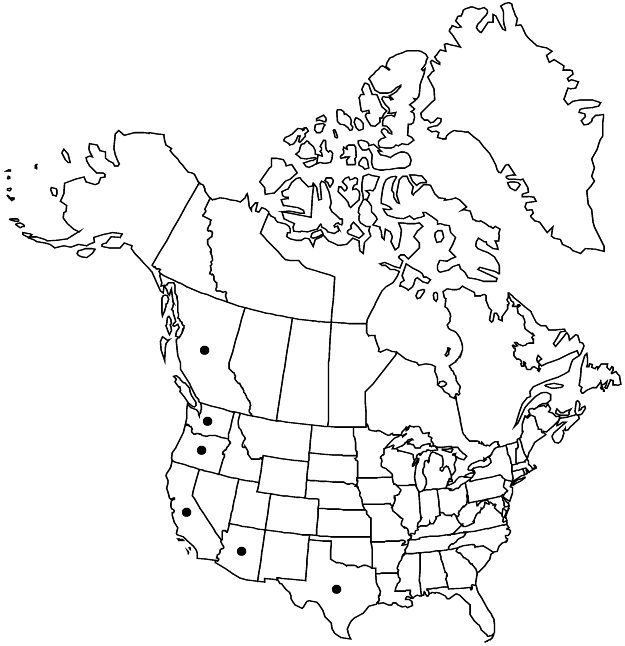Difference between revisions of "Crassula connata"
in H. G. A. Engler, Nat. Pflanzenfam. ed. 2, 18a: 389. 1930,.
FNA>Volume Importer |
FNA>Volume Importer |
||
| Line 10: | Line 10: | ||
|name=Tillaea connata | |name=Tillaea connata | ||
|authority=Ruiz & Pavón | |authority=Ruiz & Pavón | ||
| + | |rank=species | ||
|publication_title=Fl. Peruv. | |publication_title=Fl. Peruv. | ||
|publication_place=1: 70, plate 106, fig. a. 1798 | |publication_place=1: 70, plate 106, fig. a. 1798 | ||
| Line 16: | Line 17: | ||
|name=Crassula connata var. erectoides | |name=Crassula connata var. erectoides | ||
|authority=M. Bywater & Wickens | |authority=M. Bywater & Wickens | ||
| + | |rank=variety | ||
}} {{Treatment/ID/Synonym | }} {{Treatment/ID/Synonym | ||
|name=Crassula connata var. eremica | |name=Crassula connata var. eremica | ||
|authority=(Jepson) M. Bywater & Wickens | |authority=(Jepson) M. Bywater & Wickens | ||
| + | |rank=variety | ||
}} {{Treatment/ID/Synonym | }} {{Treatment/ID/Synonym | ||
|name=Crassula connata var. subsimplex | |name=Crassula connata var. subsimplex | ||
|authority=(S. Watson) M. Bywater & Wickens | |authority=(S. Watson) M. Bywater & Wickens | ||
| + | |rank=variety | ||
}} {{Treatment/ID/Synonym | }} {{Treatment/ID/Synonym | ||
|name=Crassula erecta | |name=Crassula erecta | ||
| − | |authority= | + | |authority= |
| + | |rank=species | ||
}} {{Treatment/ID/Synonym | }} {{Treatment/ID/Synonym | ||
|name=Tillaea erecta | |name=Tillaea erecta | ||
| − | |authority= | + | |authority= |
| + | |rank=species | ||
}} {{Treatment/ID/Synonym | }} {{Treatment/ID/Synonym | ||
|name=Tillaea leptopetala | |name=Tillaea leptopetala | ||
| − | |authority= | + | |authority= |
| + | |rank=species | ||
}} | }} | ||
|hierarchy=Crassulaceae;Crassula;Crassula connata | |hierarchy=Crassulaceae;Crassula;Crassula connata | ||
| Line 56: | Line 63: | ||
-->{{#Taxon: | -->{{#Taxon: | ||
name=Crassula connata | name=Crassula connata | ||
| − | |||
|authority=(Ruiz & Pavón) A. Berger et al. in H. G. A. Engler | |authority=(Ruiz & Pavón) A. Berger et al. in H. G. A. Engler | ||
|rank=species | |rank=species | ||
| Line 71: | Line 77: | ||
|publication year= | |publication year= | ||
|special status= | |special status= | ||
| − | |source xml=https://jpend@bitbucket.org/aafc-mbb/fna-data-curation.git/src/ | + | |source xml=https://jpend@bitbucket.org/aafc-mbb/fna-data-curation.git/src/f50eec43f223ca0e34566be0b046453a0960e173/coarse_grained_fna_xml/V8/V8_300.xml |
|genus=Crassula | |genus=Crassula | ||
|species=Crassula connata | |species=Crassula connata | ||
Revision as of 22:27, 16 December 2019
Plants terrestrial, annual. Stems erect, red in age, simple or bushy-branching, 2–6(–10) cm. Leaf blades ovate to oblong, 1–3(–6) mm, apex acute to rounded. Inflorescences often compact; flowers (1–)2 per node. Pedicels 0.2–6 mm. Flowers (3–)4[–5]-merous; sepals lanceolate, 0.5–2 mm, apex acute to acuminate; petals narrow-triangular, 0.6–1.5 mm. Follicles ascending, 1–2-seeded, ovoid; old follicles ascending, boat-shaped. Seeds ellipsoid, 0.3–0.6 × 0.1–0.3 mm, not papillate, dull, rugulose. 2n = ca. 16.
Phenology: Flowering spring.
Habitat: Open, gravelly places, on mossy rocks
Elevation: 0-1500 m
Distribution

B.C., Ariz., Calif., Oreg., Tex., Wash., Mexico, Central America (Guatemala), South America (Argentina, Chile, Uruguay).
Discussion
M. Bywater and G. E. Wickens (1984) proposed five varieties, four partly in the flora area, where they have largely overlapping ranges and overlapping characteristics. Further, some supposed differences probably result from local and year-to-year rainfall differences. Although probably having some genetic basis, these varieties seem too poorly defined to be useful (R. V. Moran 1992b).
S. L. Hatch et al. (1990) were first to report Crassula connata in Texas, from a 1968 collection (F. B. Jones 7292), suggesting that it may be a recent arrival there. It was first discovered in British Columbia and Washington in 1977 (A. Ceska and O. Ceska 1980) and is treated as a rare native species by the heritage program in British Columbia and the Washington Natural Heritage Program, where it has a habitat typical of other southern disjunct natives (A. Ceska, pers. comm.).
Selected References
None.
